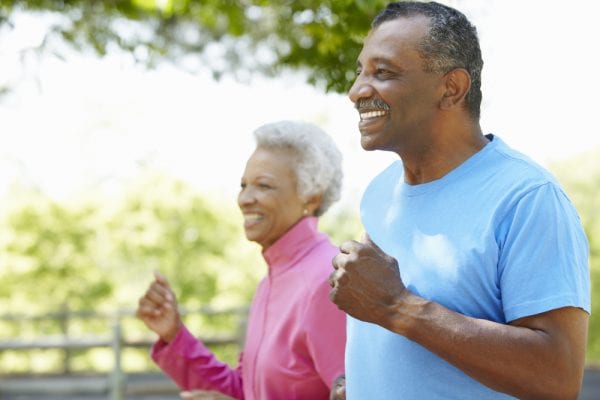
Is exercise good for joint pain, and is walking good for joint pain? These are questions that many arthritis sufferers have, and a lack of information often prevents individuals from pursuing exercise as a healthy treatment option.
Not only is exercising with joint pain and arthritis possible, but it is actually recommended for reducing symptoms and keeping the joints active for many years to come.1
Exercises can be modified to the needs of joint pain sufferers so that they are safe and target specific joints that are symptomatic.2
Here is an explanation of how working out can help with joint pain and five ways that exercise is beneficial for people who have various types of joint pain.
1. Exercise Increases Blood Flow
Every part of the human body requires a healthy blood flow to continue functioning properly, even the joints.3,4 Exercise is a great way to boost blood flow and encourage better circulation to the body’s various parts. When a person with weak or pained joints exercises, the synovial membrane receives more of the oxygen and nutrients it needs to thrive.5
2. Exercise Builds Muscle Around the Joints
Many people think of exercise as a way to bulk up and build muscle, but there are also important applications for arthritis patients. Exercise strengthens the muscles that surround the joints, as well as the neighboring ligaments and tendons.5,6 When all of these components are strong, they can cushion and support the joints more effectively and reduce joint pain.
3. Exercise Lubricates and Nourishes the Joints
Joint pain is also reduced during and after exercise because physical activity boosts the circulation of synovial fluid, which is used to lubricate joints.5 Exercise also moves water molecules that put weight on the joints and cause pain. In this way, exercise helps to bring oxygen and nutrients to the joints without blockages.
4. Exercise Improves Range of Motion
However, exercise isn’t all about getting the heart rate up and sculpting muscle. It’s also a great way to improve flexibility and range of motion in the joints.6 When the joints are regularly exposed to movement, they stay more limber and active. This way, when daily activities require strain on the joints, they are more flexible and can handle the excess pressure.
5. Exercise Removes Cellular Waste
Another important benefit of exercise is that it removes cellular waste through a natural biological process.5 Damaged cells in the joints that are no longer helping the body can be eliminated with regular exercise and reduce pain over time.
Exercises to Help with Joint Pain
Arthritis pain sufferers should always ask their doctors before starting a new workout regimen. But as a general rule, these are some exercises that are often recommended for exercising with arthritis.7
- Swimming
- Walking
- Elliptical machine
- Bicycling
- Body weight strength training
- Yoga
- Pilates
- Taichi
Many athletes who have arthritis use over-the-counter topical pain-relievers like JointFlex to provide immediate and long-lasting relief after exercise. But no matter which exercises one chooses, it’s important to begin slowly and gradually increase time and weight.8 Fortunately, there are many different types of exercise and easy ways to modify exercises based on skill and ability. This means that all arthritis sufferers can discover workouts they enjoy and can benefit from.
REFERENCES FOR FIVE WAYS EXERCISE CAN HELP REDUCE JOINT PAIN
1. Benefits of exercise for osteoarthritis. Arthritis Foundation. Retrieved November 2, 2018 from https://www.arthritis.org/living-with-arthritis/exercise/benefits/exercise-knee-osteoarthritis.php.
2. Bartlett, S. The role of exercise in arthritis management. Johns Hopkins Arthritis Center. Retrieved November 2, 2018 from https://www.hopkinsarthritis.org/patient-corner/disease-management/role-of-exercise-in-arthritis-management/#ihelp.
3. Benefits of exercise. MedlinePlus. Retrieved November 2, 2018 from https://medlineplus.gov/benefitsofexercise.html.
4. Casey, D. P. & Joyner, M. J. (2015 April). Regulation of increased blood flow (hyperemia) to muscles during exercise: A hierarchy of competing physiological needs. Physiological Reviews, 95, 549-601. Retrieved November 2, 2018 from National Center for Biotechnology Information https://www.ncbi.nlm.nih.gov/pmc/articles/PMC4551211/.
5. How exercise helps your joints. Arthritis Today Magazine. Retrieved November 2, 2018 from http://blog.arthritis.org/living-with-arthritis/exercise-benefits-for-joints/.
6. Johnston, B. D. (2018 September). Benefits of exercise. The Merck Manual: Consumer Version. Retrieved November 2, 2018 from https://www.merckmanuals.com/home/fundamentals/exercise-and-fitness/benefits-of-exercise.
7. Recommended activities. Arthritis Foundation. Retrieved November 1, 2018 from https://www.arthritis.org/living-with-arthritis/exercise/arthritis-friendly/.
8. Physical activity for arthritis. Centers for Disease Control and Prevention. Retrieved November 1, 2018 from https://www.cdc.gov/arthritis/basics/physical-activity-overview.html.
